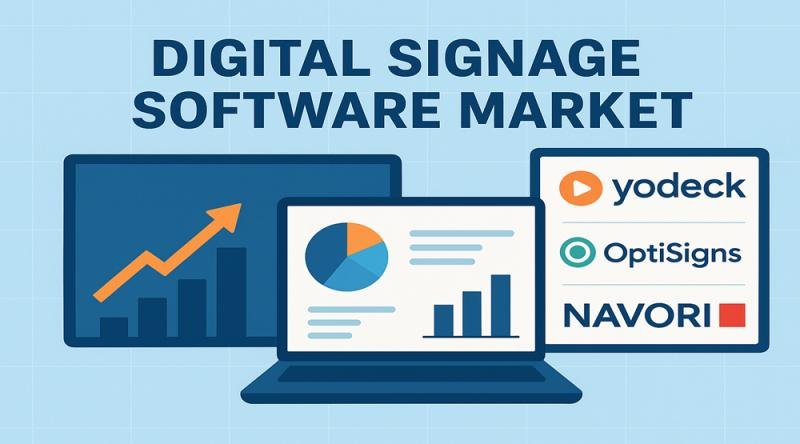In the evolving arena of digital communications, digital signage software has become a critical infrastructure for brands and organizations seeking to display dynamic content across screens and networks globally. This strategic article explores the competitive landscape, profiles key players, conducts a SWOT analysis of leading firms, and outlines investment themes within the digital signage software market.
Get deeper insights into competitive positioning and strategic benchmarking: Download our sample Digital Signage Software Market report here → https://researchnester.com/sample-request-4822
Top Companies & Their Strategies
Below are six standout companies – established and emerging – shaping the digital signage software market. Each is differentiated by distinctive strategic strengths such as product innovation, regional reach or cost advantage.
1. Yodeck
Yodeck has carved a niche as a cloud-first digital signage software vendor that emphasises ease-of-use, affordability and remote management. Its platform allows users to deploy a screen in three simple steps and offers a free tier (first screen free) which lowers the barrier to adoption. By targeting SMBs and multisite operations with low setup friction and drag-and-drop content management, Yodeck is leveraging cost and simplicity as a competitive asset.
2. OptiSigns
OptiSigns positions itself as a flexible platform that supports “any screen, any hardware” and offers 150+ app integrations across verticals such as retail, education, transportation and media agencies. The strategic strength lies in hardware-agnostic deployment and extensive integrations, which allow customers to pick hardware best suited to their geographies or budgets – a potential advantage in price-sensitive markets and regional roll-outs.
3. Navori Labs
Navori Labs is a long-standing specialist in digital signage software delivering enhanced visual richness and advanced CMS capabilities. With a focus on enterprise-grade deployments, it has a reputation for high quality and sophisticated offering. Its strategy appears to target customers with complex signage networks and high demands for analytics, integrations and content sophistication.
4. Broadsign
Broadsign concentrates on the digital-out-of-home (DOOH) segment, offering software that enables media owners to automate networks, manage content and monetise inventory via programmatic advertising. By bridging digital signage software with ad-sales workflows and revenue optimisation, Broadsign taps into the advertising ecosystem rather than only internal communications. This gives it a distinct value proposition especially in retail, transit, airports and large venues.
5. Poppulo (formerly with Four Winds Interactive)
Poppulo, after its combination with FWI, offers a global employee-communications and digital signage platform tailored to large enterprises. The strength here is deep vertical focus (corporate communications, large scale signage networks) and global customer base. The strategy emphasises integration, enterprise-grade support, and full-service solutions (hardware + software + services).
Explore detailed profiles of top players and new entrants in this space – access your free sample report → https://researchnester.com/sample-request-4822
6. ScreenCloud
ScreenCloud is a cloud-native offering aimed at remote team use, distributed networks and multi-location businesses. Analyst reviews highlight its strength in remote device management and scalability for teams. Its strategic emphasis is on software simplicity tied with broad hardware compatibility – aimed at businesses that need manageable digital signage across many screens with limited IT burden.
7. (Emerging) SpinetiX
Although more niche, SpinetiX is increasingly relevant – for example it recently launched a unified cloud platform (SpinetiX HUB) aimed at simplifying and scaling signage networks. Its strength resides in providing modular, secure and enterprise-ready signage solutions with cloud, data integration and compliance-standards aligned.
8. (Emerging) OnSign TV
While less covered in major articles, OnSign TV is often cited amongst “best digital signage software” lists with strong positioning for small-to-medium deployments and education/retail verticals. Its strategy appears to focus on budget-friendly, quick-deploy solutions targeting cost-conscious customers.
View our Digital Signage Software Market Report Overview here: https://www.researchnester.com/reports/digital-signage-software-market/4822
SWOT Analysis for Leading Companies
Here is a combined SWOT analysis capturing key strengths, weaknesses, opportunities and threats common to the leading providers in the digital signage software market.
Strengths
• Many providers offer cloud-based digital signage software with remote device management, content scheduling and multi-screen support – features highly valued by users.
• Diverse vertical reach: companies serve retail, transportation, hospitality, corporate communication, DOOH advertising and more, providing varied use-cases and resilience.
• Scalability and hardware agnosticism in key players (e.g., OptiSigns, Screen Cloud) permit deployment across regions and device types – an asset in global roll-outs or multi-format networks.
• Integration and monetisation capabilities (e.g., Broadsign’s programmatic DOOH workflows) offer value beyond basic signage – helping customers drive revenue, not just display content.
Weaknesses
• Many digital signage software firms face fragmentation of hardware-ecosystem and must support dozens of players/devices/standards-this can raise costs or complexity for both vendor and customer.
• Feature parity across platforms is uneven; a smaller vendor might struggle to match enterprise-grade analytics, security or workflow support offered by larger players.
• Regional coverage and local support remain a challenge; companies headquartered in North America or Europe may find scaling into Asia-Pacific, Middle East or Africa harder due to localisation, channel constraints or regulatory compliance.
• Pricing pressures and low-cost entrants (especially in SMB segment) may erode margins, particularly for vendors used to enterprise pricing models.
Opportunities
• The increasing digitisation of physical spaces (retail stores, airports, smart buildings, hospitality) creates large addressable opportunities for digital signage software, especially when integrated with analytics, IoT and data-driven content.
• The rise of programmatic digital-out-of-home (DOOH) advertising opens gateways for signage software providers to move beyond internal fixed-use cases into revenue-generating networks (as seen with Broad sign).
• Growth in emerging markets (Asia-Pacific, Latin America, Middle East) offers geographic expansion potential, especially if vendors can localise and partner with hardware/installation channels.
• Integration with other enterprise systems (CRM, business intelligence, IoT dashboards) enables signage software to become a component of broader enterprise digital-transformation initiatives rather than a standalone solution.
Threats
• Hardware commoditisation and low-cost screen/display players may reduce the relative value of premium software offerings; customers may opt for basic CMS or open-source solutions and customise in-house.
• Cybersecurity risks and regulatory compliance (GDPR, SOC2, data protection) become more significant for signage networks spanning public spaces – software vendors failing to keep up could face reputational or legal damage.
• Competitive pressure from larger technology firms or display/hardware manufacturers bundling signage software may challenge standalone software vendors; for example, display manufacturers or IoT platform providers entering the market.
• Customer resistance due to long upgrade cycles or hesitant budget allocation for signage software (especially in cost-sensitive markets) may depress software growth or force vendors into low-margin segments.
Access a complete SWOT breakdown with company-specific scorecards: Claim your sample report → https://researchnester.com/sample-request-4822
Investment Opportunities & Trends
In the digital signage software market, several investment themes are worth noting – especially from the perspective of strategic acquirers, growth-stage investors and regional expansion players.
Investment Themes
• M&A Activity: Software vendors are consolidating to gain scale, global reach and product breadth. For example, Navori Labs recently acquired Signage live, creating the world’s largest independent channel-only CMS provider by installed base. Such consolidation reduces competition and supports product-ecosystem expansion (API-first, headless CMS, monetisation tools) in the signage software space.
• Startup and Funding Growth: Emerging providers targeting niche verticals or cost-sensitive regions (e.g., SMB signage in Asia-Pacific or digital-menu boards for retail) are attracting capital. The rise of cloud-native providers like Yo deck show that software-led models (versus hardware-heavy) can capture market share.
• Technology Integration: The convergence of digital signage software with data-analytics, programmatic advertising, IoT displays and interactive kiosks is driving differentiation. For example, Broad sign’s platform emphasises programmatic DOOH inventory, audience targeting and campaign optimisation. Investors should watch firms enabling these integrations as having competitive advantage.
• Regional Expansion & Vertical Focus: Regions such as Asia-Pacific, Middle East and Latin America are underpenetrated for advanced digital signage software networks. Vendors who localise offerings (language support, installation partners, compliance) and target verticals like retail, transportation, healthcare can unlock growth. For example, enterprise solutions for healthcare or higher education (via platforms such as Poppulo/FWI) are becoming more common.
• Hardware-agnostic SaaS models: Investment interest is shifting toward software-first models decoupled from expensive proprietary hardware. Companies offering a subscription-based CMS with remote management and device-agnostic compatibility (e.g., Screen Cloud, OptiSigns) are appealing in flexible procurement environments.
• Policy and infrastructure tailwinds: Smart city initiatives, digital out-of-home (DOOH) advertising regulation, and building-digitisation programs provide structural support. As physical spaces get smarter and more networked, demand for signage software (capable of delivering dynamic content, dashboards, way-finding, emergency messaging) grows.
Recent Notable Activity (Last 12 Months)
• Navori Labs’ acquisition of Signagelive (August 2025) consolidates a channel-only CMS provider with enhanced API-first and monetisation capabilities.
• SpinetiX launching a unified cloud-platform (SpinetiX HUB) to simplify multi-device management and compliance in enterprise signage networks (October 2025).
• In terms of product launches, vendors increasingly emphasise integrated programmatic/DOOH features (e.g., Broadsign’s software for in-store retail media).
• Segmentation data show that the digital signage software market is tailoring solutions per industry (retail, education, transportation) and per region, highlighting vertical and regional opportunity.
Get exclusive intelligence on M&A, funding pipelines and regional opportunities: Download your sample report → https://researchnester.com/sample-request-4822
Related News:
https://www.linkedin.com/pulse/why-businesses-prioritizing-infrastructure-asset-management-svzwf/
https://www.linkedin.com/pulse/what-real-world-benefits-ai-retail-biohealth-trends-bmazf/
Contact Data
AJ Daniel
Corporate Sales, USA
Research Nester
77 Water Street 8th Floor, New York, 10005
Email: info@researchnester.com
USA Phone: +1 646 586 9123
Europe Phone: +44 203 608 5919
About Research Nester
Research Nester is a one-stop service provider with a client base in more than 50 countries, leading in strategic market research and consulting with an unbiased and unparalleled approach towards helping global industrial players, conglomerates and executives for their future investment while avoiding forthcoming uncertainties. With an out-of-the-box mindset to produce statistical and analytical market research reports, we provide strategic consulting so that our clients can make wise business decisions with clarity while strategizing and planning for their forthcoming needs and succeed in achieving their future endeavors. We believe every business can expand to its new horizon, provided a right guidance at a right time is available through strategic minds.
This release was published on openPR.


















